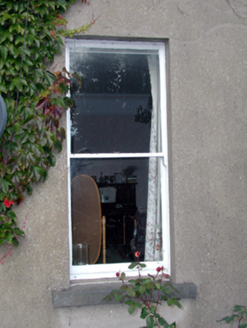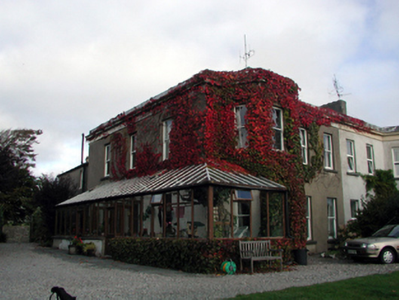Survey Data
Reg No
22816057
Rating
Regional
Categories of Special Interest
Architectural
Original Use
House
In Use As
House
Date
1870 - 1880
Coordinates
258270, 101714
Date Recorded
03/10/2003
Date Updated
--/--/--
Description
Semi-detached three-bay two-storey house, c.1875, retaining original fenestration with single-bay two-storey canted bay window to left, three-bay two-storey side elevation to south-west, and two-bay two-storey lower return to north-west. Renovated, c.1975, with single-bay single-storey glazed projecting end bay added to left (south-west) extending into four-bay single-storey conservatory along side (south-west) elevation. One of a pair forming part of a group of four. Hipped (shared) slate roof behind parapet (pitched to return) with clay ridge tiles, rendered chimney stacks, and cast-iron rainwater goods. Hipped glazed roof to conservatory in timber frame. Unpainted rendered walls with rendered frieze on stringcourse, and moulded rendered cornice having zinc-lined blocking course over to parapet. Square-headed window openings (some round-headed window openings to return) with stone sills. 1/1 timber sash windows. Square-headed openings to porch with glazed timber panelled double doors, and fixed-pane timber lights. Set back from line of road in own grounds with front (south-east) elevation fronting away from road having landscaped grounds to front, and rear (north-west) elevation fronting on to road.
Appraisal
An attractive, well-composed middle-size house, built as one of a pair (with 22816056/WD-26-16-56) forming part of a group of four (with 22816054 – 5/WD-26-16-54 – 5), which retains most of its original form and historic fabric. The house incorporates a number of details typical of the period of construction, including a canted bay window, a variety of profiles to the window openings, and reserved Classical detailing. However, the additional porch/conservatory is not an entirely positive attribute of the design. The house, together with the remainder in the group, forms an appealing element of the townscape, and attests to the development of Tramore as a Victorian seaside resort in the mid to late nineteenth century.



